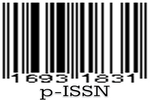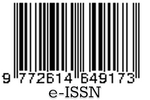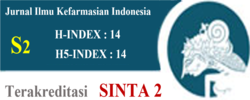Ethanolic extract of Parkia speciosa Hassk leaves innovation of gastroretentive tablet: standardization and optimization
Abstract
Parkia speciosa ethanol leaves extract contains flavonoid, tannin, and terpen as ulcus peptic remedy. These compounds exhibit limited activity in the stomach due to the short gastric residence time following oral administration. The formulation of gastroretentive tablets can overcome this limitation. This research aims to control the prolonged release of drugs in the stomach to increase bioavailability and characterize the ethanol leaves extract. Extraction was carried out by maceration using ethanol, followed by standardization based on specific and non-specific parameters extract. Gastroretentive tablet was formulated with combination of HPMC-K4M and chitosan using factorial design 22. Effects of compositional factors and their interactions on gastroretentive tablet was observed on hardness, friability, floating lag/duration time, swelling index, and mucoadhesive time. Results standardization extract showed that extract met the required criteria for both specific parameters (organoleptic properties and phytochemical screening) and non-specific parameters (moisture content, loss on drying, water/ethanol-soluble extract content). Based on with DX®10 analysis, the optimum formulation was achieved with 20.25% of HPMC-K4M and 10.26% of chitosan. The analysis of the optimum formulation characteristics was as follows: friability (0.22%), hardness (29.53 N), mucoadhesive time (22.86 hours), floating lag/duration time (27.54 minutes; 12 hours), and swelling index (312.82%). Result revealed that gastroretentive tablets formulated with ethanol extract of Parkia speciosa leaves improve gastric residence duration and promote better bioavailability.
References
[2] N. A. Fithri, Fitrya, T. Shabrina, A. Akbari, and D. Yulanri, “Antioxidant Activity Analysis and Standardization of Parkia speciosa (Petai) Pods Ethanol Extract,” Sci. Technol. Indones., vol. 4, no. 1, pp. 5–10, 2019, doi: 10.26554/sti.2019.4.1.5-10.
[3] T. Samrit et al., “Ethanolic extract of Parkia speciosa pods exhibits antioxidant and anti-inflammatory properties in lipopolysaccharide-induced murine macrophages by inhibiting the p38 MAPK pathway,” Heliyon, vol. 10, no. 20, p. e39641, 2024, doi: 10.1016/j.heliyon.2024.e39641.
[4] A. K. Azemi, M. L. Nordin, K. A. Hambali, N. A. Noralidin, S. S. Mokhtar, and A. H. G. Rasool, “Phytochemical Contents and Pharmacological Potential of Parkia speciosa Hassk. for Diabetic Vasculopathy: A Review,” Antioxidants, vol. 11, no. 2, pp. 1–14, 2022, doi: 10.3390/antiox11020431.
[5] S. S. Y. H. R. Kehar Singh, “A Review On Gastro Retentive Drug Delivery System: Novel Approach With The Future Perspectives,” Int. J. Pharm. Sci., vol. 02, no. 06, pp. 606–621, 2024, doi: 10.5281/zenodo.11550881.
[6] E. V. Blynskaya, S. V. Tishkov, V. P. Vinogradov, K. V. Alekseev, A. I. Marakhova, and A. A. Vetcher, “Polymeric Excipients in the Technology of Floating Drug Delivery Systems,” Pharmaceutics, vol. 14, no. 12, pp. 1–25, 2022, doi: 10.3390/pharmaceutics14122779.
[7] N. Nurhalifah, P. D. Sundawan, S. C. Veronita, S. I. Puji Destria, S. Nuryamah, and N. Yuniarsih, “Literature Review Article: Drug Delivery System Held in the Stomach (Gastroretentive),” J. Soc. Res., vol. 2, no. 1, pp. 126–133, 2022, doi: 10.55324/josr.v2i1.472.
[8] A. Ainurofiq et al., “Chitosan as floating-mucoadhesive polymers in gastroretentive drug delivery,” Sci. Eng. Heal. Stud., vol. 17, 2023, doi: 10.69598/sehs.17.23010002.
[9] V. Kumar, S. Somkuwar, and A. K. Singhai, “A recent update on gastro retentive drug delivery systems,” vol. 27, no. February, pp. 125–144, 2024.
[10] M. A. D. S. S. and P. F. Iqbal, “World Journal of Pharmaceutical research FORMULATION,” SJIF J., vol. 2, no. 5, pp. 1685–1703, 2021, doi: 10.20959/wjpr202415-33309.
[11] G. Anusha, R. Sunayana, M. Ponnam, and B. A. Kumar, “Asian Journal of Pharmaceutical Research and Development,” Asian J. Pharm. Res. Dev., vol. 8, no. 6, pp. 77–80, 2020.
[12] S. Chauhan, S. Tyagi, P. Maan, G. Noida, and U. Pradesh, “International Journal of Newgen Research in Pharmacy & Healthcare Volume-1, Issue-2, December 2023 www.ijnrph.com,” no. 2, pp. 129–134, 2023.
[13] K. Vinchurkar, J. Sainy, M. A. Khan, S. Mane, D. K. Mishra, and P. Dixit, “Features and Facts of a Gastroretentive Drug Delivery System-A Review,” Turkish J. Pharm. Sci., vol. 19, no. 4, pp. 476–487, 2022, doi: 10.4274/tjps.galenos.2021.44959.
[14] J. Riyanto, L. Lutojo, and S. Sunarto, “Aplikasi Penggunaan Konsentrat Pemacu Pertumbuhan untuk Penggemukan Sapi Potong di Karanganyar,” PRIMA J. Community Empower. Serv., vol. 4, no. 1, p. 7, 2020, doi: 10.20961/prima.v4i1.37988.
[15] S. A. Nitave, V. A. Patil, and A. A. Kagalkar, “Review on gastro retentive drug delivery system (GRDDS),” Int. J. Pharm. Sci. Rev. Res., vol. 27, no. 2, pp. 90–95, 2014, doi: 10.33772/pharmauho.v7i1.11693.
[16] S. Jain and B. Srinivasan, “An Insight on the Strategical Approach of Gastro-retentive Drug Delivery System,” Pharm. Sci, vol. 3, no. 2, pp. 34–54, 2023.
[17] N. Nurfitriyana, H. Harmita, and I. Iskandarsyah, “In vitro study of a transfersomal gel preparation containing lynestrenol as a transdermal drug delivery system,” Int. J. Appl. Pharm., vol. 12, no. Special Issue 1, pp. 242–244, 2020, doi: 10.22159/ijap.2020.v12s1.FF052.
[18] R. Malasiya and T. P. Shukla, “Formulation development and evaluation of gastroretentive mucoadhesive tablets of glimepiride using natural polymers,” J. Drug Deliv. Ther., vol. 10, no. 4-s, pp. 153–159, 2020, doi: 10.22270/jddt.v10i4-s.4264.
[19] R. Khan, “Int J Pharm Bio Sci 2013 Apr; 4(2): (P) 630-646 Gastroretentıve Drug Delıvery System-A Revıew,” vol. 4, no. 2, pp. 630–646, 2013, [Online]. Available: www.ijpbs.net
[20] H. Chinthaginjala, G. C. Barghav, C. M. Reddy, B. Pradeepkumar, and H. Abdul Ahad, “Formulation and in vitro Evaluation of Floating Tablets of Dicloxacillin Sodium Using Different Polymers,” J. Young Pharm., vol. 11, no. 3, pp. 247–253, 2019, doi: 10.5530/jyp.2019.11.51.
[21] M. Rahamathulla, N. Alam, U. Hani, Q. Ibrahim, and Y. Alhamhoom, “Development and in vitro evaluation of effervescent floating matrix tablet of neritinib: An anticancer drug,” Pak. J. Pharm. Sci., vol. 34, no. 4, pp. 1297–1303, 2021, doi: 10.36721/PJPS.2021.34.4.REG.1297-1303.1.

This work is licensed under a Creative Commons Attribution-NonCommercial-ShareAlike 4.0 International License.
Licencing
All articles in Jurnal Ilmu Kefarmasian Indonesia are an open-access article, distributed under the terms of the Creative Commons Attribution-NonCommercial-ShareAlike 4.0 International License which permits unrestricted non-commercial used, distribution and reproduction in any medium.
This licence applies to Author(s) and Public Reader means that the users mays :
- SHARE:
copy and redistribute the article in any medium or format - ADAPT:
remix, transform, and build upon the article (eg.: to produce a new research work and, possibly, a new publication) - ALIKE:
If you remix, transform, or build upon the article, you must distribute your contributions under the same license as the original. - NO ADDITIONAL RESTRICTIONS:
You may not apply legal terms or technological measures that legally restrict others from doing anything the license permits.
It does however mean that when you use it you must:
- ATTRIBUTION: You must give appropriate credit to both the Author(s) and the journal, provide a link to the license, and indicate if changes were made. You may do so in any reasonable manner, but not in any way that suggests the licensor endorses you or your use.
You may not:
- NONCOMMERCIAL: You may not use the article for commercial purposes.
This work is licensed under a Creative Commons Attribution-NonCommercial-ShareAlike 4.0 International License.




 Tools
Tools





















